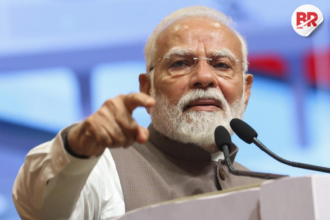
On May 8, 2025, India reported 50 swarm drones and missile attacks by Pakistan on military bases in Jammu, Udhampur, and Pathankot.
The strikes came at night and early morning, but were swiftly intercepted by India’s air defenses. There were zero casualties. Zero damage. And zero doubt about India’s readiness.

Across the skies of Jammu and Jaisalmer, residents witnessed sudden flashes—blasts that led to a temporary power cut. But what didn’t go dark was India’s resolve.
Within moments, Indian forces neutralized the threat with S-400 Sudarshan Chakra. Pakistan, as usual, violates Ceasefire Violations. They called it “politically motivated.” But you can’t deny radar footage—or a growing pattern of desperation.
#BREAKING: Jammu at present is under attack. Drones across the night sky. Blackout has happened across the city. Indian forces neutralising the threat. pic.twitter.com/lvUxq5Opgv
— Aditya Raj Kaul (@AdityaRajKaul) May 8, 2025
Visuals from Jammu earlier this evening.
India has neutralised the attack on vital installations and military stations in Jammu.
This could also be a ploy by Pakistan to identify India’s Air Defence capability and response mechanism. pic.twitter.com/kg2sg7UhJF
— Aditya Raj Kaul (@AdityaRajKaul) May 8, 2025
Pakistan’s Pattern of Provocation
This isn’t the first time Pakistan has tried using drones to breach Indian territory. On February 16, 2024, and again on July 9, 2024, Pakistani drones were spotted in Poonch.
Each time, India’s army fired, pushed them back, and launched search operations to check for arms drops. No surprises. Just the same old tactic from a country stuck in the past.
According to The Hindu, Indian forces remained vigilant, ensuring no payloads were dropped. These drones weren’t delivering peace—they were fishing for chaos.
Retaliation Was Never Just a Word
Let’s not forget: this came just weeks after India launched precision strikes on terror camps in Pakistan—following the April 22 attack that killed Indian soldiers in Kashmir. India acted. Pakistan reacted—with clumsy theatrics and drone games. They claimed they shot down five Indian jets and 29 drones. India laughed. The world looked on—and saw where the credibility lies.
Even global powers took notice. The U.S., Russia, and China all called for restraint. But India didn’t flinch. As Western capitals lecture about “de-escalation,” India lives in the reality of cross-border terror—and still stands taller.
In 2025, India is no longer asking the world to see our pain. We’re showing our power. Whether it’s in space, tech, or security, the message is clear: you poke us, we retaliate. You lie, we expose. And when drones come in the night, we shoot first—and talk later.
Also Read INS Vikrant Destroys Karachi Port: India’s Answer to Pakistan’s Provocations- Diwali Came Early












